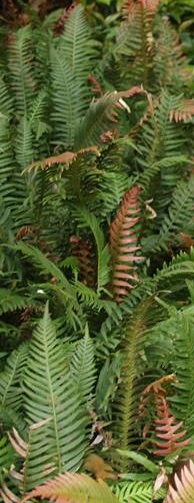"Become a Fern Expert and carve out a career working with ferns"
Learn which ferns occur naturally in Australia along with:
- how to identify ferns,
- where to obtain relevant accurate information,
- how to propagate ferns, and
- growing and using ferns in baskets, terrariums, and landscapes.
Australia is home to a wide variety of ferns; and many Australian Ferns have become popular garden, or indoor plants in places beyond their natural habitat. Certain Australian tree ferns for instance, are extremely popular garden plants in other countries. Some others (eg. Australian Maiden hair Ferns) are widely grown as indoor plants.
Any type of plant culture deals can be somewhat unpredictable, and requires both knowledge and experience to be successful. The best way to treat any fern is always going to be different from place to place, time to time and according to what you are trying to get from the plant. Taking a course like this helps you not only gather factual information; but also develops a "feel" for the way you should adapt to different plant cultivars and different growing conditions.

Course Structure
There are eight lessons including a special project in this course. This course is designed as a detailed look at identification and culture of Australian Native Ferns.
Emphasis is placed on the horticulturally valuable species. The content of each of the eight lessons is as outlined below:-
1. Introduction -Review of the system of plant identification, general characteristics of the ferns, main groups, information contacts (ie: nurseries, seed, clubs, etc.)
2. Culture - Planting, mulching, watering, pest & disease, feeding, pruning, protection from wind, salt air, etc.
3. Propagation -Methods of propagating ferns. Propagation of selected varieties.
4. The Most Commonly Grown Varieties - Maidenhairs, tree ferns, stags, elks, common ground ferns.
5. Other Important Groups - Blechnum, Nephrolepis, Pteris, etc.
6. Other Varieties - Hares foot ferns, Bracken, Fans.
7. Making the Best Use of Native Ferns - In containers, in the ground, as indoor plants, growing and showing, growing for profit (to sell the plants or what they produce).
8. Special Assignment - A major project on one genera of ferns.
Course Duration: 100 hours
Start Date: You can start the course at any time to suit you.
Scope of Ferns Covered by this Course
Ferns have been around for millions of years -they are prehistoric plants.
 Australian ferns include a few which occur outside of Australia, some that are tropical, and others which are native to temperate regions.
Australian ferns include a few which occur outside of Australia, some that are tropical, and others which are native to temperate regions.
Ferns do not have flowers or fruits; but they do have stems, roots and leaves. The stem (rhizome) is often below the ground and insignificant. From the stem grows numerous leaves (fronds) and wiry roots.
The main families of ferns considered in this course are:
- SCHIZAEACEAE -Comb Ferns, a primitive family, rarely cultivated.
- GLEICHENIACEAE -Coral Ferns & Fan Ferns
- HYMENOPHYLLACEAE -Filmy Ferns
- CYATHEACEAE -Treeferns (genus Cyathea)
- DICKSONIACEAE -Treeferns (Genus Dicksonia)
- DENNSTAEDTIACEAE -Bracken & other Ground ferns
- PTERIDACEAE -Brakes
- ADINANTACEAE -Maidenhairs
- POLYPODIACEAE -Kangaroo ferns, Elks, Stags etc.
- DAVALLIACEAE -Hares Foot Ferns
- ASPLENIACEAE -Spleenworts
- ASPIDIACEAE -Shield Ferns
- BLECHNACEAE -Rasp ferns & Water Ferns
WHAT NEXT?
Register to Study - Go to “It’s Easy to Enrol” box at the top of the page and you can enrol now.
or
Get Advice – Email us at info@acsedu.co.uk OR
Use our FREE COUNSELLING SERVICE to contact a tutor
CLICK TO CONTACT US